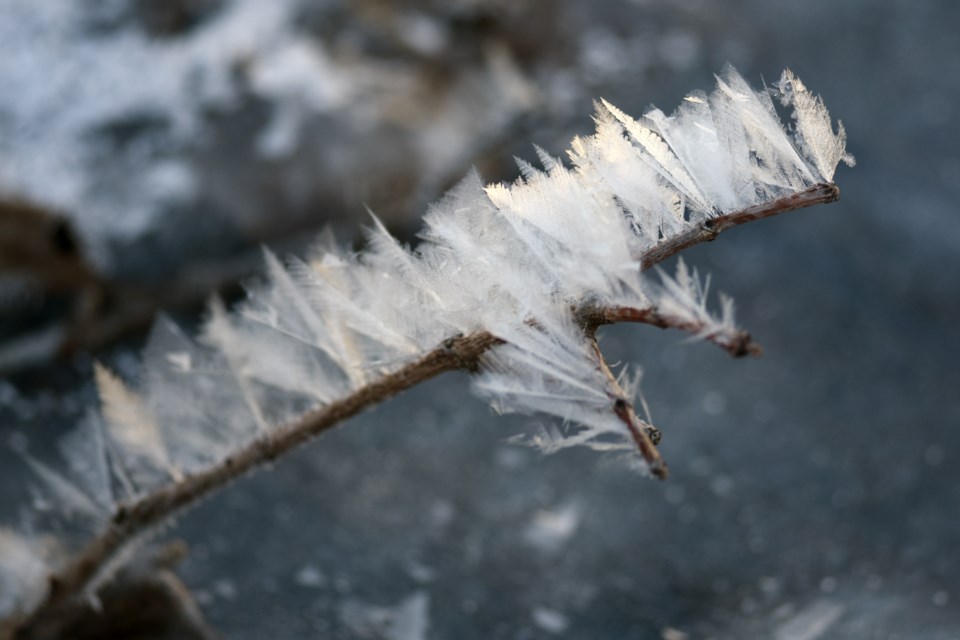A single snowflake is a beautiful thing. However, as the old saying goes, “too much of a good thing may be bad for you.” When a gang of snowflakes get together, work en masse and fill the driveway knee-deep or reduce visibility through the car windshield to about an arm’s length ahead, it’s hard to retain an appreciation for their delicate beauty.
Living in this part of the world, at the halfway mark between the gloriously hot equator and the frigidly cold pole, we can expect a 50/50 split in the weather between those two extremes. Actually, it’s kind of nice to have a variety of weather systems dance through the backyard.
Frost, ice and snow are just winter versions of summer’s dew, mist and rain. Ever since a couple of hydrogen atoms teamed up with an oxygen atom way back when, water has become the lifeblood of all things living on this planet. Water is one of science’s greatest wonders, for whether it comes as a gas, a liquid or a solid, it’s still water! Nothing else like it in the world.
Hoar frost is more than just frozen dew. Well, actually, it has nothing at all to do with dew. When the temperature drops to that truly magical point where water transforms itself, the gaseous micro-droplets of water vapour within the air grabs on to a nearby twig or grass blade. As the vapour turns to a solid, the frost crystals grow and, in so doing, fine crystals appear. Sometimes there is enough water vapour to create large flakes of frost that we call hoar frost.
Ice formation is quite different from frost creation, as ice forms directly from liquid water. (Both frost and snow start as vapour. Remember that. It may be worth a mark on a test someday. Ya never know.) This liquid water is a marvel to start with, as the surface layer of a pond is actually different from the water within the pond. Water molecules are chummy things, liking to hang out with their own kind. Big group hugs all around! This is why liquid water is denser than air: water molecules like to party together.
The water molecules that find themselves at the surface of the pond realize that the air isn’t “one of them,” and so try to hold tighter to the water molecules below. This little action is called surface tension, and is the first step in creating ice. An interesting facet of water (no, I didn’t say faucet) is that once the surface water reaches 4 degrees Celsius, it sinks! And as the cold water sinks, it displaces the lower, warmer water to rise upward to be next in line to get chilled. When the entire water body is at a uniform 4 C, ice making can commence.
Once all the water is cooled, and the air temperature is below freezing, ice forms on the upper surface of the pond. Once it becomes a solid, it can no longer interact with the liquid below and sink. Therefore, the result is that ice skating takes place on the surface, not the bottom, of a pond. Marvellous!
As mentioned above, snow crystals start as water vapour within the air. When the freezing point is attained, and as there is nothing to attach to (as hoar frost did with a twig), the crystals begin clinging to each other in mid-air. As they gain weight and begin to fall, more water vapour is collected and the flake takes on the six-pointed symmetrical shape that we all know and love.
As each flake lands with a gentle crash upon the earth, they lie helter-skelter, with their points sticking out and snagging other flakes. As they grow in number and the layer thickens upon the land, a lot of air is trapped between these crystals. It is that trapped air that insulates the ground below from the cold air above, and at the same time this insulating layer traps the heat that is slowly being given off from the soil itself. The term ‘blanket of snow’ is actually quite accurate.
Do any two snowflakes ever look the same? That’s hard to tell, as they are so small and either evaporate quickly or are crushed by their neighbours. People have tried to document snowflake designs, either on photographic film or by sketching them while looking through a microscope. It would seem that there are four main shapes of snowflakes: a needle-like spike; long, hollow, six-sided prism; a six-sided plate; and the most enchanting of all, the six-pointed star.
The shape is determined by where it forms. High clouds make spikes in the very cold part of the atmosphere, and with every 13 C change in temperature, a new form becomes dominant. The rare star-shaped crystals form at very cold temperatures while the plates appear in ‘warm’ weather, just below the freezing point.
Snow, ice and frost — aren’t they just the greatest things going? Hmm, I have to admit, as upbeat as I’ve tried to make this article, I’m still really, really hoping for an early spring!
